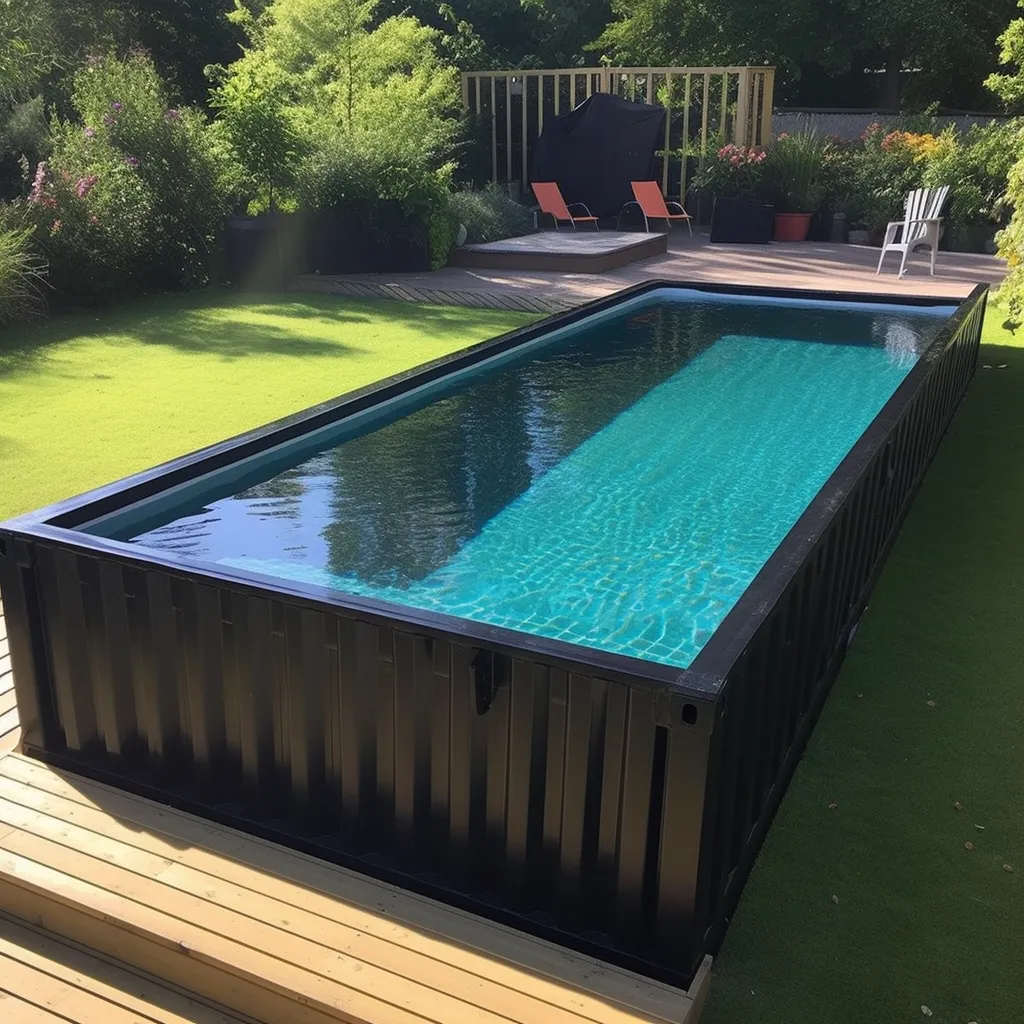Can Shipping Container Pools Be In Ground? A Guide To Container Pools & Architecture
Shipping container pools are becoming a more popular alternative to traditional swimming pools. They are modular, affordable, eco-friendly, and easy to install. But can shipping container pools be in ground? And what are the benefits of using shipping containers in architecture? In the article, we will find answers to these questions and more.
Can shipping container pools be in ground? Exploring the possibilities
What are shipping container pools? Shipping container pools are swimming pools made out of upcycled (used) shipping containers. They are typically prefabricated and delivered to the site ready to use. Shipping containers are steel boxes adesigned to transport goods by ship, truck, or rail. They come in standard sizes and shapes, which makes them ideal for creating modular structures.

Shipping container pools can range from 8 to 40 feet in length and 4 to 8 feet in depth. Do you know you can customize these shipping container pools with various features such as windows, stairs, jets, lighting, heating, filtration systems, etc.? Next, let’s learn the fantastic advantages of shipping container pools.
Shipping container architecture
Why shipping container in architecture? Shipping container architecture refers to building design incorporating steel shipping containers as the primary structural component. This type of architecture is also famous as cargotecture, a portmanteau of cargo and architecture, or arkitainer.

One of the applications of shipping container architecture is to create pools that you can install on the ground or above ground. Shipping container pools are prefabricated modules you can easily transport and install on-site. You can customize them to fit different sizes, shapes, depths, and finishes. Some shipping container pools also have features such as windows, filters, heaters, jets, and lighting.
An architecture that you can use for your benefit
Shipping container architecture has many advantages, such as customization, strength, durability, modularity, availability, and affordability. People consider it eco-friendly, as it reuses existing materials and saves thousands of kilograms of steel.
Shipping container pools are not only functional but also aesthetic. Moreover, they can add a unique touch to any backyard or landscape design. They can also complement other shipping container structures like homes or offices. Shipping container pools exemplify how shipping container architecture can transform ordinary spaces into extraordinary ones.
Advantages of shipping container pools
Shipping container pools have many benefits over traditional swimming pools.
Affordability
Shipping container pools can cost as low as $28,000 and up to $50,000, depending on the size and features. This is much cheaper than building an inground pool which can cost an average of $49,000, according to HomeAdvisor.
Durability
Steel, which is strong and resistant to harsh environments, makes up shipping containers. They can withstand high pressure and weight when stacked or buried underground. They can also last up to 20 years with proper care and maintenance.
Eco-friendliness
Shipping container pools reuse existing materials that would otherwise end up in landfills or scrapyards. They also reduce the amount of concrete and other resources needed for building a pool foundation.
Portability
Trucks or cranes can easily transport shipping container pools to any location. If needed, they can also relocate them without much hassle.
Flexibility
You can customize shipping container pools according to their preferences and needs. Combining them with other containers or structures creates more complex designs.
In-ground shipping container pools
Can shipping container pools be in ground? Yes, you can install shipping container pools partially or fully underground depending on the site conditions and preferences of the owners. However, before doing so, you need to consider some factors.

Site preparation
You need to level and excavate the site where you place the shipping container pool according to the dimensions of the pool. You must also check the soil quality and drainage system for stability and water flow.
Foundation
The shipping container pool needs a solid foundation to support its weight and prevent it from shifting or sinking over time. Depending on the soil type and depth, you can make the foundation of concrete slabs or piers.
Insulation
The shipping container pool needs adequate insulation around its walls and floor to prevent heat loss and condensation in colder climates or seasons. The insulation material should also protect the steel from corrosion caused by moisture and chemicals. Some common insulation materials are spray foam, polyurethane, fiberglass, wool, mineral wool, etc.
Ventilation
The shipping container pool needs proper ventilation around its walls and roof to prevent mold growth and air stagnation. The ventilation system should also allow fresh air intake and exhaust for safety reasons. Some common ventilation methods are vents, fans, ducts, etc.
Aspects you should concern about before installing a shipping container pool

Installation options
One of the main advantages of shipping container pools is their versatility. Depending on your site conditions and personal preferences, you can install them either inground or above ground. When determining the best option for you, take these factors into account.
Cost
Installing a shipping container pool inground will require more excavation work, increasing the cost of labor and materials. You may also need to reinforce the container walls with concrete or steel beams to prevent them from collapsing under the soil pressure. On the other hand, installing a shipping container pool above ground will require less digging, but you may need to build a deck or platform around it to make it accessible and aesthetically pleasing.
Space
Installing a shipping container pool inground will take up less space in your backyard, as it will be flush with the ground level. This can be ideal if you have a small or narrow lot or want to preserve your lawn or garden area. However, installing a shipping container pool above ground will create more visual impact and height in your backyard, which can be desirable if you want to make a statement or enjoy panoramic views from your pool.
Maintenance
Installing a shipping container pool inground will make it easier to keep clean and free of debris, as the surrounding soil will protect it from wind and rain. However, installing a shipping container pool above ground will make it easier to access and inspect for leaks or damages and drain and refill when needed.
Sealing and waterproofing requirements
Another essential factor when choosing a shipping container pool is properly sealing and waterproofing it. Shipping containers are designed to transport goods across oceans, not to hold water. Therefore, before using them as swimming pools, they need some modifications.
Applying an epoxy coating
The most common way to seal and waterproof a shipping container pool is by applying an epoxy coating on the interior walls and floor. This creates a smooth and durable surface that prevents rusting and corrosion from chlorine or salt water. Some companies also use fiberglass liners or vinyl membranes instead of epoxy coatings for added protection.
Installing an insert
Another way to seal and waterproof a shipping container pool is by installing an insert inside the container that acts as an independent shell holding water. You can make this insert from fiberglass, steel, plastic, or other materials resistant to water damage. This method can minimize the likelihood of leaks occurring between the insert and the walls of the container.
Cost comparisons with traditional swimming pools

A primary reason for people opting for shipping container pools instead of traditional swimming pools is they are more affordable. Did you know that an average inground swimming pool costs about $49,000 in 2021, while an average above-ground swimming pool costs about $6,000?
A standard 20-foot-long shipping container pool costs about $28,000, while a larger 40-foot-long one costs about $50,000. These prices include delivery, installation, filtration system, and basic features such as stairs, lights, and jets.
The final cost of your shipping container pool
The final cost of your shipping container pool will depend on several factors, such as,
- The size
- Quality
- Condition of the container
- The type of coating or liner used
- The level of customization
- Additional features (windows, dividers, heaters, or covers)
You may also pay attention to factors in other expenses such as permits, landscaping, decking, or fencing.

Also read-Make a ship container your perfect home.
Conclusion
Can shipping container pools be in ground? Shipping container pools are an innovative and affordable alternative to traditional in-ground pools. They offer many advantages, such as portability, modularity, eco-friendliness, and smart features. Before buying a container pool for your backyard or property, you should research and weigh the pros and cons carefully. A container pool can be a great addition to your house if you choose wisely and maintain it properly.




One Comment